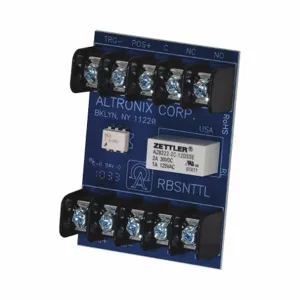Altronix RBSNTTL sensitive relay is an electronic component designed to control the flow of electrical current based on low-voltage input signals. It is used in security systems, automation and access control applications, where it can trigger actions like opening doors, activating alarms or turning on lights in response to specific conditions.
Features:
- It features phenolic / fibreglass construction for durability and resistance to environmental factors.
- This sensitive relay features DPDT contacts, enabling it to control two independent circuits or electrical loads simultaneously.
- It operates within a temperature range of -13 to 131 degrees F.
- This relay can operate under relative humidity conditions of 85% with a tolerance of +/- 5%.
Frequently Asked Questions:
Q. What are the contact ratings for this Altronix RBSNTTL sensitive relay?
A. It has a contact rating of 1A at 120VAC or 2A at 28VDC.
Q. What is the difference between DPDT (double pole double throw) and SPST (single pole single throw) switches?
A. DPDT switches feature two contact sets, enabling them to control two separate electrical circuits or devices simultaneously. They offer greater versatility and are suitable for applications like relay control & motor direction reversal. In contrast, SPST switches possess just one set of contacts and manage a single circuit, making them suitable for simple ON / OFF functions, such as household light switches & other electronic devices.
Q. What safety precautions should I take when using this Altronix sensitive relay?
A.
- Avoid exposing the relay to voltages or currents exceeding its specified ratings.
- Wire the relay correctly to avoid short circuits or loose connections.
- Prevent exposure to moisture or water, especially if the relay is not suitable for outdoor use.
- Avoid overloading the relay by connecting it to devices that draw more current than its rated capacity.
- Operate the relay within the specified temperature range to prevent overheating or performance issues.
- Ensure adequate ventilation and avoid covering the relay to prevent heat buildup.
- Periodically inspect the relay and its connections to check for wear, damage or loose parts.
- Pay attention to the correct polarity when connecting DC voltage sources.
- Use protective enclosures in outdoor or harsh environments to shield the relay from dust, moisture and other environmental factors.
- Properly ground the relay to prevent electrical shock or interference.
- Always disconnect power before any adjustment or repairing the relay or connected circuits.
- Keep the product manual and documentation handy for reference, troubleshooting and maintenance.
Q. What temperature range is suitable for storing this Altronix RBSNTTL sensitive relay?
A. It stays safely stored within a temperature range of -13 to 158 degrees F.










